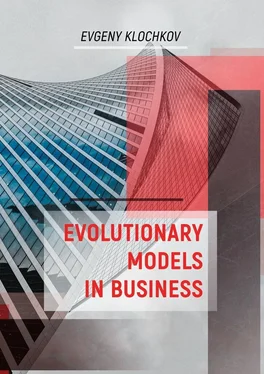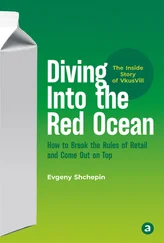Evgeny Klochkov - Evolutionary Models in Business
Здесь есть возможность читать онлайн «Evgeny Klochkov - Evolutionary Models in Business» — ознакомительный отрывок электронной книги совершенно бесплатно, а после прочтения отрывка купить полную версию. В некоторых случаях можно слушать аудио, скачать через торрент в формате fb2 и присутствует краткое содержание. ISBN: , Жанр: popular_business, на английском языке. Описание произведения, (предисловие) а так же отзывы посетителей доступны на портале библиотеки ЛибКат.
- Название:Evolutionary Models in Business
- Автор:
- Жанр:
- Год:неизвестен
- ISBN:9785005192585
- Рейтинг книги:4 / 5. Голосов: 1
-
Избранное:Добавить в избранное
- Отзывы:
-
Ваша оценка:
- 80
- 1
- 2
- 3
- 4
- 5
Evolutionary Models in Business: краткое содержание, описание и аннотация
Предлагаем к чтению аннотацию, описание, краткое содержание или предисловие (зависит от того, что написал сам автор книги «Evolutionary Models in Business»). Если вы не нашли необходимую информацию о книге — напишите в комментариях, мы постараемся отыскать её.
Evolutionary Models in Business — читать онлайн ознакомительный отрывок
Ниже представлен текст книги, разбитый по страницам. Система сохранения места последней прочитанной страницы, позволяет с удобством читать онлайн бесплатно книгу «Evolutionary Models in Business», без необходимости каждый раз заново искать на чём Вы остановились. Поставьте закладку, и сможете в любой момент перейти на страницу, на которой закончили чтение.
Интервал:
Закладка:
The answer to these questions lies in the special view of business structures described and justified in this study. The object of the study is to create a new model of business vision, as well as to develop recommendations for the model application. The work was based on classical principles and models that are already known and have proven themselves in practice. These are Charles Darwin’s Theory of Evolution, genetic algorithms, Spiral Dynamics, the Rainforest model of the Silicon Valley from V. Hwang and G. Horowitt, the Blue Ocean Strategy of W. Kim and R. Mauborgne, Corporate Lifecycle Model from Dr. I. Adizes, C. Christensen’s Jobs-to-be-Done concept, R. Dilts’ Pyramid of Logical Levels, the T.O.T.E. Model, Carl Jung’s theory of archetypes, the Propaganda concept from E. Bernays, D. Ariely’s Predictably Irrational, PSYCHEA model of O. Klepikov and A. Murazanov.
The synthesis of these models makes it possible to create not just another model, but to formulate a novel outlook on the existing models and tools in the field of management, which are of a mechanistic nature. The new model takes into account not only mechanistic relations, but also organic, social, and psychological relationships. It enables prediction of the competitors’ behavior and gives understanding of their capabilities and development potential. The study is structured according to the principle of describing classical theoretical models, identifying their principles of operation and interconnection with each other, analyzing practical examples, and then the final practice-oriented model for entrepreneurs and managers is proposed and described in stages.
Chapter 1. Theoretical Models
In December 2019, during the plenary session at the “100 Steps to a Favorable Investment Climate” conference, an important thesis about the future of business was aired by Konstantin Polunin, a partner of Boston Consulting Group (BCG): “Companies will determine their right to exist in terms of the cumulative systemic effect rather than in terms of return for shareholders”.
In recent years, it is often suggested in the professional community that the study of complex, self-generating, self-organizing, nonlinear, and adaptive systems will become the most relevant in the 21st century, the main meaningful goal of the organization and its mission (rather than the self-preservation of the company) being the key factors to these systems. The new paradigm will view business structures not as organizational models, but as living organisms. The solution to the task of building the next generation structure will lie more in biology and psychology than in engineering and finance. But in order to understand this thesis, it is worthwhile to study more closely what it can be based on, what theoretical models may underlie this assumption. The book will describe the models that form the basis of the hypothesis that it is much more effecient and far-sighted to perceive business as a living organism.
1.1. Types of Cooperation Models
To begin with, some starting point should be determined, and the idea described in the book Reinventing Organizations by F. Laloux shall serve as a basis. The book comprehends the accumulated experience of human cooperation models, which reflect the mankind development history and consciousness development level, and presents a novel idea that can describe the existing complex interrelationships in more detail than generally known concepts. Organizations as models of cooperation between people are always bound to the currently dominant people’s worldview and consciousness development stage. Each time humanity as a species changed its method of world cognition, it grew to new, more effective types of organization. At the same time, such growth did not occur evenly, evolution proceeded in leaps and bounds, like transformation of a caterpillar into a butterfly. Each rise to a new stage of self-consciousness opens up unprecedented abilities and opportunities for humanity, and each new stage of development endows a new model of organization.
Let us consider the following models of organizations in today’s business environment. The companies are divided based on the principle of the underlying organizational structure, and for the convenience of distinguishing them, each is labelled with a color in compliance with the ideas of F. Laloux.
Family Business
Business is built according to ethnicity or family ties. The management style is manual control. The decision-making body is often comprised of a family members council, with the leader serving as a chairman of the council and announcing decisions. In such a business, the role of the leader does not imply autocracy, but rather is to coordinate opinions, lead and control the wealth of the family. For these companies, healthy social relationships in the group are more important than production schedules. The leader’s life belongs to the family where he serves the clan, and not vice versa. The use of awards in the form of reward for individual achievement in such organizations is unlikely, since the reward separates good workers from the rest of the group, i.e. from the family.
Small Business, Startups (Red Organizations)
This business is characterized by the presence of strong personalities who quickly find themselves at the top of the power pyramid. Leaders in such organizations show a high level of energy, take risks, are ready to fight “for territory”, while being able to create innovations and challenge the system. Thinking in this case is formed by the opposites, creating a black and white picture of the world, and in the end everyone is divided into winners and losers. The management style is maintained at the level of manual control. Leaders show tough hegemony in decision making. There is no planning in these companies, since the stake is made on achieving immediate results. Red Organizations are well adapted to cope with chaos, but they are not fit to create complex results in a stable environment where planning and strategy development are possible.
Formal Hierarchies (Amber Organizations)
The overall structure is established in the form of a rigid pyramid with a cascade of formalized orders from bosses to subordinates. In such companies, processes and procedures are very tightly regulated, which leads to a flourishing bureaucracy. Rule-making authority is associated with a social role rather than a strong personality, thus creating stable organizational structures that are sustainable and capable of large-scale development. Notable examples of Amber Organizations are government agencies, the church, and the army. Authority is comparable to a priest in vestments or a general in uniform, and it doesn’t matter what kind of person he is – the form determines the authority. The distribution of remuneration is carried out in accordance with the position and length of service. Each element of the organization understands its exact location and has to act according to the rules of the system. The outlook on life in such structures is static, i.e. there are unshakable laws that divide things into right and wrong. If members of the organization do the right thing, they will be rewarded, and should their behavior fail to conform to the accepted norms, members of the group breaching the established code of ethics may be rejected by the community.
Companies of this level have an understanding of causation, which allows to reproduce past experience and leads to creation of a planning system. Planning and implementation of plans are strictly separated. The thinking takes place “above”, the execution is done “below”. Management is based on the principle of “give orders and follow up”. The philosophy of the Amber Organizations suggests that employees are mostly lazy, dishonest, need supervision, they need to be monitored and told exactly what is required of them. New ideas, individual achievement, critical thinking, and self-expression are not encouraged. Human resources are virtually completely interchangeable. Order and stability – subordination, formalized internal processes, and clear rules – reign in these companies.
Читать дальшеИнтервал:
Закладка:
Похожие книги на «Evolutionary Models in Business»
Представляем Вашему вниманию похожие книги на «Evolutionary Models in Business» списком для выбора. Мы отобрали схожую по названию и смыслу литературу в надежде предоставить читателям больше вариантов отыскать новые, интересные, ещё непрочитанные произведения.
Обсуждение, отзывы о книге «Evolutionary Models in Business» и просто собственные мнения читателей. Оставьте ваши комментарии, напишите, что Вы думаете о произведении, его смысле или главных героях. Укажите что конкретно понравилось, а что нет, и почему Вы так считаете.












